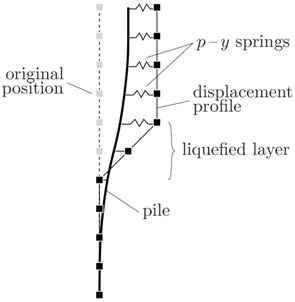Deep Foundation Subject to Lateral Spreading: Difference between revisions
No edit summary |
No edit summary |
||
| Line 34: | Line 34: | ||
=== Mesh Geometry === | === Mesh Geometry === | ||
This example considers a layered soil profile in which a weaker liquefied layer is present between two layers of stronger material. The upper and lower layers are assumed to consist of identical soil material. | This example considers a layered soil profile in which a weaker liquefied layer is present between two layers of stronger material. The upper and lower layers are assumed to consist of identical soil material. The geometry of the mesh depends on the number of specified nodes and the specified depth of the deep foundation. In the example input file, there are 81 nodes and the foundation extends to a depth of 40 m below the ground surface. '''Note:''' The Matlab scripts which can be used to generate input files are set to consider a maximum of 200 nodes. If more nodes are desired, the scripts will require modification. | ||
=== Boundary Conditions === | === Boundary Conditions === | ||
Revision as of 00:54, 5 January 2012
Example prepared by: Christopher McGann and Pedro Arduino, University of Washington
Return to OpenSees Examples Page
This article discusses an OpenSees analysis of a single deep foundation subject to a kinematic loading which simulates lateral spreading. The deep foundation is embedded in a layered soil profile in which a liquefiable layer separates an upper crustal layer and a deeper, denser soil layer. The laterally-loaded deep foundation is modeled as a beam on nonlinear Winkler foundation (BNWF). Elastic beam-column elements are used for the deep foundation, and nonlinear p-y spring elements represent the soil. Lateral spreading is simulated in the BNWF model by imposing an applied displacement profile to the soil end of the nonlinear springs in a similar manner to that presented by Brandenberg et al. (2007). The displacement profile is constant across the upper crustal layer, varied linearly across the liquefied layer, and is zero in the lower soil layer.
This example also briefly discusses the use of Matlab to generate input files for OpenSees. The scripts necessary for this process are provided. These scripts allow for the generation of OpenSees input files based on various specified parameters such as the diameter and depth of the deep foundation and the properties of the soil layers.
Provided with this article are several files. Files which are required for the analysis are indicated. The files include:
- The example input file, lateralSpreadPile.tcl (required for analysis)
- The main Matlab driver file, makeInput.m, which can be used to generate an OpenSees input file for the type of analysis described in this article
- The auxiliary Matlab files, getAPIstiffness.m, getBrinch.m, and mDataSort.m, which are support the main driver file, makeInput.m
All of the files mentioned above can be downloaded here.
To run this example, the user must download the input file, lateralSpreadPile.tcl. The additional files described above are not essential to the analysis. They are provided to demonstrate how to create OpenSees input files using outside software and to allow the user to investigate alternative soil-pile systems.
The provided input file is initially described in the discussion below, followed by a description of how to use the Matlab scripts, and some representative results obtained for the example analysis.
Model Description

The setup for this example is similar to that discussed in the [[]] example. The user is encouraged to refer to that former example for any details which are omitted in the current discussion. The laterally-loaded deep foundation is simulated using a BNWF technique in which the foundation is modeled with beam-column elements and the soil is modeled using a series of nonlinear p-y springs. An idealized schematic of the laterally-loaded pile model is provided in Fig. 1.
The pile axis is oriented in the z-coordinate direction, and all of the nodes are initially located on the z-axis (x- and y- coordinates are zero). Node numbering for each set of nodes begins at the top of the pile. The model is created with three separate sets of nodes:
- fixed spring nodes (numbers 2-81 in example)
- slave spring nodes (numbers 202-281 in example)
- pile nodes (numbers 501-581 in example)
Mesh Geometry
This example considers a layered soil profile in which a weaker liquefied layer is present between two layers of stronger material. The upper and lower layers are assumed to consist of identical soil material. The geometry of the mesh depends on the number of specified nodes and the specified depth of the deep foundation. In the example input file, there are 81 nodes and the foundation extends to a depth of 40 m below the ground surface. Note: The Matlab scripts which can be used to generate input files are set to consider a maximum of 200 nodes. If more nodes are desired, the scripts will require modification.
Boundary Conditions
Material and Element Definitions
Loading and Analysis
Results
References
- American Petroleum Institute (API) (1987). Recommended Practice for Planning, Designing and Constructing Fixed Offshore Platforms. API Recommended Practice 2A(RP–2A), Washington, D.C., 17th edition.
- Brandenberg, S.J., Boulanger, R.W., Kutter, B.L., and Chang, D. (2007). "Static pushover analyses of pile groups in liquefied and laterally spreading ground in centrifuge tests." Journal of Geotechnical and Geoenvironmental Engineering, ASCE, 133(9), 1055–1066.
- Brinch Hansen, J. (1961). "The ultimate resistance of rigid piles against transversal forces." Bulletin No. 12, Geoteknisk Institute, Copenhagen, 5–9.
- McGann, C.R., Arduino, P., and Mackenzie-Helnwein, P. (2011). "Applicability of conventional p-y relations to the analysis of piles in laterally spreading soil." Journal of Geotechnical and Geoenvironmental Engineering, ASCE, 137(6), 557-567.
- McGann, C.R., Arduino, P., and Mackenzie-Helnwein, P. (2012). "Simplified procedure to account for a weaker soil layer in lateral load analysis of single piles." Journal of Geotechnical and Geoenvironmental Engineering, ASCE, in press.